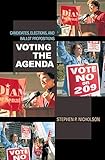Voting the Agenda : Candidates, Elections, and Ballot Propositions / Stephen P. Nicholson.
Material type: TextPublisher: Princeton, NJ : Princeton University Press, [2022]Copyright date: ©2005Description: 1 online resource (188 p.) : 12 line illus. 20 tablesContent type:
TextPublisher: Princeton, NJ : Princeton University Press, [2022]Copyright date: ©2005Description: 1 online resource (188 p.) : 12 line illus. 20 tablesContent type: - 9780691223841
- Direct democracy -- United States
- Direct democracy
- Elections -- United States
- Elections
- Political psychology
- Voting -- United States
- Voting
- POLITICAL SCIENCE / Political Process / Campaigns & Elections
- Atkeson, Lonna Rae
- Barber, Benjamin
- Beilenson, Anthony
- Bradley, Tom
- Campbell, Angus
- Congressional Quarterly
- Donovan, Todd
- Feinstein, Diane
- Florida, elections in
- Gronke, Paul
- Independents
- Indian gaming
- Los Angeles Times
- Matsui, Robert
- Proxmire, William
- Rohrabacher, Dana
- Verba, Sidney
- Willens, Harold
- Wright, Gerald C
- Zaller, John
- abortion issues
- affirmative action issues
- civil liberties issues
- coattail voting
- crime issues
- death penalty
- economic issues
- education issues
- gun control issues
- healthcare reform issues
- heresthetics
- horse meat consumption
- ideology
- illegal immigrant issues
- incumbency
- information environments
- initiatives
- institutional responsibilities
- interest groups
- midterm elections
- morality issues
- nativism
- on-line evaluation models
- physician-assisted suicide
- referenda
- same-sex marriages
- social choice theory
- state legislative elections
- statewide issues
- ticket-splitting
- toxics issues
- 324.973 22
- JK1976
- online - DeGruyter
| Item type | Current library | Call number | URL | Status | Notes | Barcode | |
|---|---|---|---|---|---|---|---|
 eBook
eBook
|
Biblioteca "Angelicum" Pont. Univ. S.Tommaso d'Aquino Nuvola online | online - DeGruyter (Browse shelf(Opens below)) | Online access | Not for loan (Accesso limitato) | Accesso per gli utenti autorizzati / Access for authorized users | (dgr)9780691223841 |
Frontmatter -- CONTENTS -- LIST OF FIGURES -- LIST OF TABLES -- PREFACE -- CHAPTER 1 Kindred Votes: An Introduction -- CHAPTER 2 A Theory of Agenda Voting -- CHAPTER 3 Studying Agendas and Direct Legislation in U.S. Elections -- CHAPTER 4 Ballot Measures and Congressional Election Agendas -- CHAPTER 5 Priming the Freeze: Nuclear Freeze Ballot Measures as a Common Basis of Candidate Voting in State and Federal Elections -- CHAPTER 6 Taking the Initiative: Illegal Immigrants, Affirmative Action, and Strategic Politicians in California’s 1994 and 1996 Elections -- CHAPTER 7 Direct Democracy: The People’s Agenda? -- NOTES -- REFERENCES -- INDEX
restricted access online access with authorization star
http://purl.org/coar/access_right/c_16ec
How do voters make decisions in low-information elections? How distinctive are these voting decisions? Traditional approaches to the study of voting and elections often fail to address these questions by ignoring other elections taking place simultaneously. In this groundbreaking book, Stephen Nicholson shows how issue agendas shaped by state ballot propositions prime voting decisions for presidential, gubernatorial, Senate, House, and state legislative races. As a readily accessible source of information, the issues raised by ballot propositions may have a spillover effect on elections and ultimately define the meaning of myriad contests. Nicholson examines issues that appear on the ballot alongside candidates in the form of direct legislation. Found in all fifty states, but most abundant in those states that feature citizen-initiated ballot propositions, direct legislation represents a large and growing source of agenda issues. Looking at direct legislation issues such as abortion, taxes, environmental regulation, the nuclear freeze, illegal immigration, and affirmative action, Nicholson finds that these topics shaped voters' choices of candidates even if the issues were not featured in a particular contest or were not relevant to the job responsibilities of a particular office. He concludes that the agendas established by ballot propositions have a far greater effect in priming voters than is commonly recognized, and indeed, that the strategic use of initiatives and referenda by political elites potentially thwarts the will of the people.
Mode of access: Internet via World Wide Web.
In English.
Description based on online resource; title from PDF title page (publisher's Web site, viewed 29. Jun 2022)


